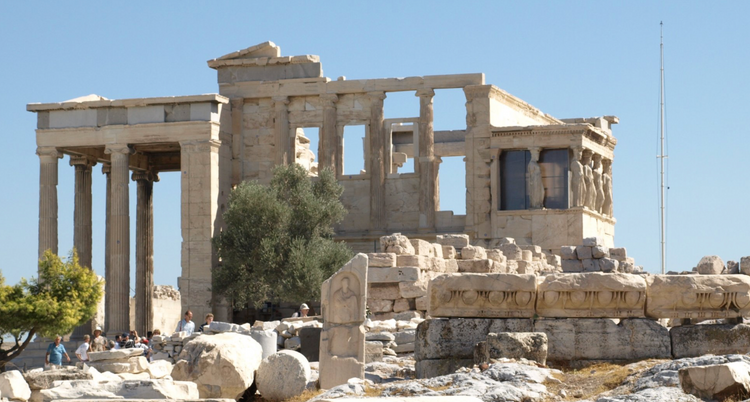
Erechtheion Temple
Rising majestically on the north face of the Athenian Acropolis, the Erechtheion is not only a marvel of ancient architectural brilliance but also a captivating portal to a mythical past. Completed between 421 and 406 BC, this iconic temple is not merely a place of worship, reminding us of the lasting power of stories and the timeless beauty of art.
What makes the Erechtheion truly unique is the intertwining of myth and history at its very foundation. Legend tells of an epic contest between Athena, goddess of wisdom, and Poseidon, god of the sea, competing for the right to be Athens' protector. The Erechtheion was carefully constructed on the very spot of this mythical contest, paying tribute to both gods and their linked destinies within its sacred walls.
Under the Erechtheion's single roof, three sections dedicated to different gods – Athena, Poseidon, and Hephaestus – are cleverly joined. Two unique porches, including the famous Porch of the Caryatids with its graceful sculpted maidens, elegantly connect these spaces. Each section holds its own hidden treasures. The east side once housed a wooden statue of Athena, even older than the temple itself. The west side, dedicated to Poseidon, contained a spring that, according to legend, was created by his mighty trident. Outside the temple, a sacred olive tree, representing Athena's gift to the city, stood as a watchful guardian.

On the south face of the Erechtheion, stands six breathtaking maidens known as Caryatids. They are not statues but stunning columns sculpted from gleaming marble. These captivating figures visitors see today are actually meticulous replicas, standing in for the originals which are now protected in the Acropolis Museum. The Caryatids seem to effortlessly support the portico's roof, their serene expressions belying their important function.
There is a story about the brilliance of the architect who designed the Caryatids. The heavy roof required thick necks on the figures, posing a compromise to their beauty. The architect cleverly disguised this necessity by sculpting their hair in long, flowing tresses down their backs, providing both visual interest and structural support. Further, he placed woven baskets on the Caryatids' heads, not only adding a decorative element but also visually transforming the weight they bear. This ingenious solution created an architectural wonder, celebrated for its beauty as much as its clever engineering.
Myths about God Poseidon
Poseidon, the earth-shaker, wielded his trident not just over crashing waves, but also through captivating myths that echoed across ancient Greece. Two tales stand out, showcasing his divine power and fascinating connection to the Athenian marvel, the Erechtheion:
Clash of the Titans: On the very ground where the Erechtheion stands, Poseidon competed with Athena for Athens' favor. Athena, ever wise, offered the olive tree, a symbol of peace and prosperity. Yet, Poseidon's might was not to be ignored. His trident-strike conjured a saltwater spring, promising the potential for naval power and trade. While Athena won the city, Poseidon was forever remembered. The spring within the temple and the marks of his trident carved into the floor forever bore witness to his presence.
Divine Stallion: Beyond the waves, Poseidon's untamed power extended to horses. In a vibrant tale, desiring Demeter, he transformed into a magnificent stallion with a mane like sea foam and eyes like the deep ocean. Though Demeter remained steadfast, their union birthed Arion, an immortal horse with a coat of shimmering gold and the gift of human speech. This mythical creature, born from Poseidon's potent virility, carried the mark of the sea god within its powerful form, a testament to the wild and unpredictable nature of the ocean.
These myths, embedded in the Erechtheion's stones, portray Poseidon not just as a wild god of the sea, but also as a creator, a respecter of human choices, and a powerful force forever tied to Athens. His presence on earth and within the waves is a reminder of his multifaceted nature.

